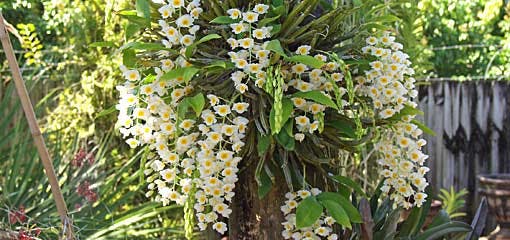
Orchids may be cultivated on trees in Hawaii, the Caribbean and else-where in the subtropics and tropics. Many are suitable in USDA Zone 11 of the continental United States. In Florida, they enhance gardens in the Keys and those situated inland along the coast north to West Palm Beach on the east coast and Ft. Myers on the west coast. In California , many orchids are hardy north to Santa Barbara; some survive up to San Luis Obispo, with protection during the winter. Distribution may extend farther north inland near bodies of water, where microclimates remain slightly warmer during cold snaps.
Match the orchid to its environment. Orchids originate in diverse habitats, from treetops in full sun to shaded swamps. Evaluate your garden's exposure, and select the appropriate species and hybrids. In sun, consider vandas. In dim light, try oncidiums, phalaenopsis and cattleyas. Many varieties are suitable for intermediate conditions. A local orchid nursery can help make selections.
Choose a tree that admits adequate light. Oaks, citrus, bottlebrush (Callistemon viminalis, C. citrinus), palms, schefflera (Brassaia actinophylla) and the less-common calabash (Crescentia alata) are prime candidates. Ficus often casts too much shade. Rough bark is an asset, though not essential for success.
Begin to attach orchids to trees when root activity on the orchids starts (usually the regular potting time). Many orchids produce roots year round, so they can be established on trees during almost any warm month. For example, since Cattleya skinneri roots and flowers in March and April, set it on trees in January or February. Late summer is appropriate for Cattleya bowringiana, since new roots emerge in early autumn, just after blooming ceases.
Position the orchid so the flowers will be enjoyed from a patio, walkway or inside the home. Match aesthetics with cultural needs.
Try seedlings, divisions or established plants. The back pseudobulbs of cattleyas rapidly adapt to life in a tree.
Set the plant directly on the trunk or limb; do not apply a pad of sphagnum moss, osmunda or other medium. Doing so may keep the surface too wet and induce rot. Roots may grow into the medium, but not onto the tree, reducing their ability to cling to the host.
Attach with cotton string that will eventually decompose and not harm the environment. It fades in a few weeks, blending in with its surroundings, and the plant will have rooted in place when the fibers deteriorate one year later. Plastic ties and monofilament are alternatives. But since these synthetics are not biodegradable, it is necessary to loosen them as the stems grow, and eventually remove them once the roots form. Hot-glue guns are another choice; take care not to injure new leads. Place a dab of glue on the rhizome or pseudobulb and hold against the tree for a few seconds.
Provide adequate care, especially during the first few months. Mist with a hose, or run a sprinkler line up into the tree. Lightweight PVC pipes are easy to hold in place. Specimens near an orchid house respond favorably to the same care given to containerized specimens. Established plants are almost carefree, although periodic applications of water and fertilizer are beneficial. When it is necessary to prune trees on which orchids grow, take care not to injure the epiphytes. Once established, orchids last for many years.
The AOS thanks Tim Anderson of Daisy Farm Nursery for this essay.








